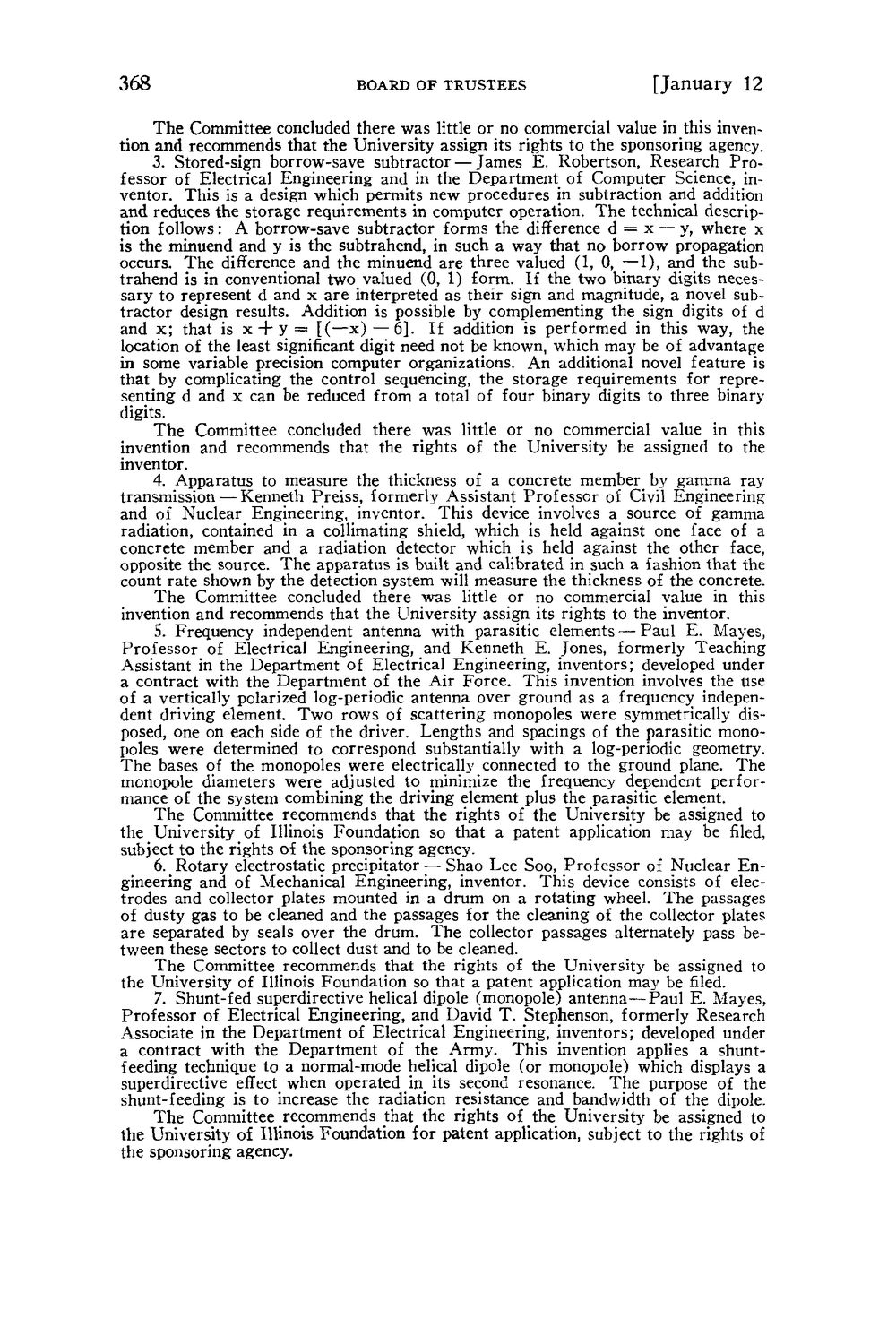| |
| |
Caption: Board of Trustees Minutes - 1968
This is a reduced-resolution page image for fast online browsing.

EXTRACTED TEXT FROM PAGE:
368 BOARD OF TRUSTEES [January 12 T h e Committee concluded there was little or no commercial value in this invention and recommends that the University assign its rights to the sponsoring agency. 3. Stored-sign borrow-save subtractor — James E. Robertson, Research Professor of Electrical Engineering and in the Department of Computer Science, inventor. This is a design which permits new procedures in subtraction and addition and reduces the storage requirements in computer operation. The technical description follows: A borrow-save subtractor forms the difference d = x — y, where x is the minuend and y is the subtrahend, in such a way that no borrow propagation occurs. The difference and the minuend are three valued (1, 0, —1), and the subtrahend is in conventional two valued (0, 1) form. If the two binary digits necessary to represent d and x are interpreted as their sign and magnitude, a novel subtractor design results. Addition is possible by complementing the sign digits of d and x ; that is x + y = [(—x) — 6 ] . If addition is performed in this way, the location of the least significant digit need not be known, which may be of advantage in some variable precision computer organizations. An additional novel feature is that by complicating the control sequencing, the storage requirements for representing d and x can be reduced from a total of four binary digits to three binary digits. The Committee concluded there was little or no commercial value in this invention and recommends that the rights of the University be assigned to the inventor. 4. Apparatus to measure the thickness of a concrete member by gamma ray transmission — Kenneth Preiss, formerly Assistant Professor of Civil Engineering and of Nuclear Engineering, inventor. This device involves a source of gamma radiation, contained in a collimating shield, which is held against one face of a concrete member and a radiation detector which is held against the other face, opposite the source. The apparatus is built and calibrated in such a fashion that the count rate shown by the detection system will measure the thickness of the concrete. The Committee concluded there was little or no commercial value in this invention and recommends that the University assign its rights to the inventor. 5. Frequency independent antenna with parasitic elements — Paul E. Mayes, Professor of Electrical Engineering, and Kenneth E. Jones, formerly Teaching Assistant in the Department of Electrical Engineering, inventors; developed under a contract with the Department of the Air Force. This invention involves the use of a vertically polarized log-periodic antenna over ground as a frequency independent driving element. Two rows of scattering monopoles were symmetrically disposed, one on each side of the driver. Lengths and spacings of the parasitic monopoles were determined to correspond substantially with a log-periodic geometry. The bases of the monopoles were electrically connected to the ground plane. The monopole diameters were adjusted to minimize the frequency dependent performance of the system combining the driving element plus the parasitic element. The Committee recommends that the rights of the University be assigned to the University of Illinois Foundation so that a patent application may be filed, subject to the rights of the sponsoring agency. 6. Rotary electrostatic precipitator — Shao Lee Soo, Professor of Nuclear Engineering and of Mechanical Engineering, inventor. This device consists of electrodes and collector plates mounted in a drum on a rotating wheel. The passages of dusty gas to be cleaned and the passages for the cleaning of the collector plates are separated by seals over the drum. The collector passages alternately pass between these sectors to collect dust and to be cleaned. The Committee recommends that the rights of the University be assigned to the University of Illinois Foundation so that a patent application may be filed. 7. Shunt-fed superdirective helical dipole (monopole) antenna—Paul E. Mayes, Professor of Electrical Engineering, and David T. Stephenson, formerly Research Associate in the Department of Electrical Engineering, inventors; developed under a contract with the Department of the Army. This invention applies a shuntfeeding technique to a normal-mode helical dipole (or monopole) which displays a superdirective effect when operated in its second resonance. The purpose of the shunt-feeding is to increase the radiation resistance and bandwidth of the dipole. The Committee recommends that the rights of the University be assigned to the University of Illinois Foundation for patent application, subject to the rights of the sponsoring agency.
| |